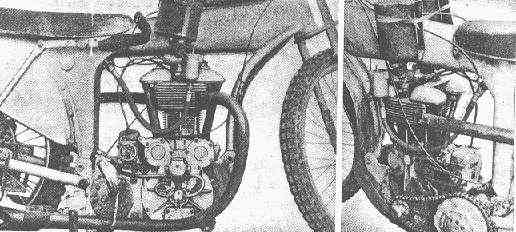


This article is an extract from
the "Motor Cycling" magazine of October 2nd, 1952.

MOTORCYCLISTS of a technical turn of mind have often been heard to say that when the speedway machine assumed its present-day standardized form, much of the interest in this particular branch of the sport was lost. Old hands recall with regret the early days of the dirt tracks, when mechanical variety was very much a feature of the "cinders."
It is interesting, therefore, to learn that there is at least one track where spectators may see a break-away from the present-day cast-in-one-mould type of mount. On the Vienna Speedway there appears regularly, and with consistent success, a machine that is not only unusual as a speedway mount but also as a motorcycle. It is owned by Leopold Killmayer, who was runner-up in the World Championships held in Paris every year from 1933 to 1935. He also raced for Plymouth in the seasons 1933 and 1935.
His mount is called an Apfelbeck, and is named after the engineer who constructed it. The unit has practically double everything, except cylinders-four valves, two carburetters, two exhausts and two camshafts are involved. Its combustion chamber is exceptionally interesting for, at the forward end, there is a right-hand exhaust valve and a left-hand inlet valve. At the rear the arrangement is reversed, so it will be seen that the mixture enters and leaves by opposite corners of the head. One sparking plug is centrally disposed in a vertical position.
The camshafts arc situated, transversely, fore and aft of the cylinder and the push rods are not enclosed within the tinning but protrude forwardly or rearwardly, as the case may be, into the rocker boxes. Each shaft operates one exhaust and one inlet valve. The horizontal down-draught carburetters, located above and at each side of the cylinder head are of Amal manufacture, but the float chambers were made by Killmayer.
The large "pans," which may be seen in the accompanying illustrations protruding over the carburetters, are air intakes designed to protect the engine from cinder dust. The general dimensions of the engine about the crankcase are the same as those of the J.A.P. 500 c.c. Speedway unit and thus, should it be necessary, the frame can accommodate a J.A.P. engine, either of 350 or 500 c.c., as well as various Continental units.
To strip the big-end, the primary chain, head and barrel are removed. By unbolting the left-hand side, not the complete half, of the crankcase, the flywheel assembly can be extracted and replaced without need for re-timing ignition or valves. The frame has no tank rail, the tank itself being used as a substitute, and the tank-cum-frame section of the machine is continued rearwardly to form an oil tank, lubrication being on the total loss system.
Because of the bumpy nature of Austrian tracks, this machine employs a form of rear suspension in addition to the simple front telescopics. A swinging fork, controlled by rubber bands, gives some 2-3-ins. of movement and, in order to ensure exceptional rigidity, the fork ends are provided with stubs which work in radial slots cut in damper plates joining the extremities of the chain and saddle stays. These stubs are provided with friction discs which can be adjusted by nuts to bear on the slotted plates.
The machine is now two years old and has been very successful except that, like many "specials", it is sometimes unreliable. Killmayer, therefore, has a spare engine at hand when riding.